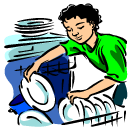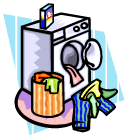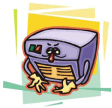| Life in the US
Appliance Usage
 In the United States the electric supply is 120 volts. To use a 220/240-volt appliance (Asian/European appliance), you must use a step up or combination converter. These can be easily purchased on the Internet or in electronic stores like Radio Shack, Circuit City, etc. These converters would be required for all appliances including shavers, food processors, grinders and any other appliances requiring electricity. In the United States the electric supply is 120 volts. To use a 220/240-volt appliance (Asian/European appliance), you must use a step up or combination converter. These can be easily purchased on the Internet or in electronic stores like Radio Shack, Circuit City, etc. These converters would be required for all appliances including shavers, food processors, grinders and any other appliances requiring electricity.
Ask your landlord or rental association to show you how to operate the various appliances when you move in, especially how to turn on the pilot light in the utility room/closet and to change the filters in the furnace. You should know how to turn off the gas, water and electric supply from the main source incase of an emergency. Be sure to find out where all the switches and knobs for these are located. Also remember to check the various meters when you move into your home. As per the law, an operational smoke alarm should be present in the home. Some areas require an additional carbon monoxide alarm. Learn how to turn the smoke alarm off in case it goes off accidentally while cooking food that generates extra smoke.
Microwave
Ensure that the dish you use to heat the food or drink is microwave safe. Do not put any metal containers in the microwave, not even aluminum foil as this might cause the microwave to blow up. Set the timer of the microwave by pressing the number keypad depending on the time you  require for heating. The time shows up on the digital screen in minutes in seconds. Most microwaves have a start, pause and clear button. require for heating. The time shows up on the digital screen in minutes in seconds. Most microwaves have a start, pause and clear button.
Many brands these days come with pre-programmed buttons … for e.g. Soup, Popcorn, Meal or Beverage. These buttons already have the timings set to heat a bowl of soup, a packet of popcorn, a dinner plate or a cup of tea/coffee. Just pressing them would be sufficient to get the microwave started. Each brand of microwave has its own power settings. It is possible for you to modify these settings, if required. Please read the manual thoroughly before using the appliance.
Dishwasher
 Ensure that the dishwasher is loaded properly. All plates and bowls need to be at the bottom and all glassware usually goes on the top. For spoons, forks and knives there is a separate compartment or stand. Place the dishwasher tablet/powder in the space provided and close the lid. Cascade and Electrasol are the commonly used dishwasher detergents. Dishwasher detergent can also be purchased in fluid form rather than as powder or tabs. Set the dishwasher to the start position by turning the main control knob. The dishwasher will start either when the door is closed or when you press the start button. Ensure that the dishwasher is loaded properly. All plates and bowls need to be at the bottom and all glassware usually goes on the top. For spoons, forks and knives there is a separate compartment or stand. Place the dishwasher tablet/powder in the space provided and close the lid. Cascade and Electrasol are the commonly used dishwasher detergents. Dishwasher detergent can also be purchased in fluid form rather than as powder or tabs. Set the dishwasher to the start position by turning the main control knob. The dishwasher will start either when the door is closed or when you press the start button.
A wash cycle may include an air dry or a heat dry cycle based on settings. The dishwasher will run its entire cycle and the knob will gradually return to its initial position. Opening the dishwasher during the wash cycle will pause the operation, which will resume the moment you shut the door.
Washer and Dryer
To wash clothes use either a powder or liquid detergent like Tide, Gain, Cheer or any other brand available in the supermarket. Static in clothes  can be avoided plus they will be softer if you use a Fabric Softener like Downy, Snuggle, etc. Measure the desired amount of detergent and softener and pour into the washer. Softener sheets like Bounce can be used instead of the liquid, in the dryer. The amount of detergent and softener needed varies on the type of clothes being washed, the wash cycle and the load quantity. Read the instructions on the containers for more details. can be avoided plus they will be softer if you use a Fabric Softener like Downy, Snuggle, etc. Measure the desired amount of detergent and softener and pour into the washer. Softener sheets like Bounce can be used instead of the liquid, in the dryer. The amount of detergent and softener needed varies on the type of clothes being washed, the wash cycle and the load quantity. Read the instructions on the containers for more details.
Put in the clothes … remember to wash colors and whites separately!!
Set the knob to the cycle of choice and then pull out gently. The washer will start to fill with water. The water level will be based on the setting of load size – small, medium or large. You can also set the water temperature to cold, warm or hot. The washer will run through the various cycles and the knob will turn all the way automatically and return to the stop position. Remove the load from the washer at the end of the cycle. Odors may develop if items are left in the washer too long. Leave the lid/door open when the washer is not in use.
Now place the semi-dried clothes in the dryer. If using, place a fabric softener sheet on top of the load at the start of the cycle. Do not add it to a warm load. Set the dryer knob to the time setting required and gently pull out. The dryer would run for the time specified and the knob would slowly rotate and return to the stop position. For the dryer to start, the door needs to be properly shut.
The lint screen must be cleaned after every load. Periodically wash the lint screen in warm, soapy water to remove the residue. Dry it thoroughly and replace. Do not operate the dryer if the lint screen is not in place or tumbling items could enter the exhaust system and cause damage to the dryer. Ask your landlord or rental agency to show you how to remove and clean the lint basket.
Air Conditioner (Central Air and Unit AC)
As summer sets in and the temperature outside begins to climb, many people seek the cool comfort of indoor air conditioning. Air conditioners come in various sizes, cooling capacities and prices.
 Window or room air conditioning units are designed to cool a room only. These units are usually placed in a window and are removed after the cooling season is over. Sometimes, window air conditioners can be permanently installed into a wall. Most window air conditioners are operated manually. You can adjust the amount of air from low to high as well as adjust the cooling temperature of the air. Some air conditioners have an “energy saver” option, which regulates the flow of air based on the room’s temperature. To ensure maximum cooling capacity and efficiency, you should keep the filter clean. During peak usage times, the filter should be inspected on a weekly basis to make sure that it is not clogged with dust. It is not recommended to leave the air conditioning units running constantly. It can result in a much higher monthly electricity bill and may, in time, burn out the unit. Window or room air conditioning units are designed to cool a room only. These units are usually placed in a window and are removed after the cooling season is over. Sometimes, window air conditioners can be permanently installed into a wall. Most window air conditioners are operated manually. You can adjust the amount of air from low to high as well as adjust the cooling temperature of the air. Some air conditioners have an “energy saver” option, which regulates the flow of air based on the room’s temperature. To ensure maximum cooling capacity and efficiency, you should keep the filter clean. During peak usage times, the filter should be inspected on a weekly basis to make sure that it is not clogged with dust. It is not recommended to leave the air conditioning units running constantly. It can result in a much higher monthly electricity bill and may, in time, burn out the unit.
Central air conditioning units (located outside the residence) will cool a large area or even an entire apartment/house by using an air distribution system. A thermostat is used to set and regulate the desired temperature. Most people can be comfortable at settings between 75 - 78oF. When the indoor temperature drops below or rises above your thermostat setting, the furnace or air conditioner runs to warm or cool the house air to the setting you selected. A thermostat, in its simplest form, must be manually adjusted to change the indoor air temperature. The thermostat usually has two settings one for the blower fan that controls air circulation (auto and on) and the other for the temperature control (heat, off and cool).
Central air conditioning may provide a more effective and efficient way of cooling your home, in addition to saving you money on your utility bill.
General Appliances
 Other common appliances used in the house are electric shavcleaners, toasters, food processors, beaters, jmakers, fridges, hair dryers, fans, heatersoperating instructions for these vary from company to company; therefore one should read the manual received along with the purchased to ensure proper and safe usage. warranty cards and mail them in Other common appliances used in the house are electric shavcleaners, toasters, food processors, beaters, jmakers, fridges, hair dryers, fans, heatersoperating instructions for these vary from company to company; therefore one should read the manual received along with the purchased to ensure proper and safe usage. warranty cards and mail them in   once you have decided to keep the product. For expensive purchases you can also purchase extended warranty. once you have decided to keep the product. For expensive purchases you can also purchase extended warranty. |
